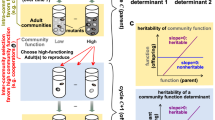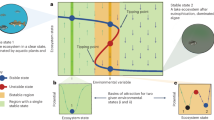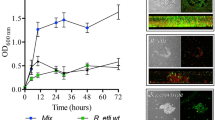Abstract
In the biosphere, many species live in close proximity and can thus interact in many different ways. Such interactions are dynamic and fall along a continuum between antagonism and cooperation. Because interspecies interactions are the key to understanding biological communities, it is important to know how species interactions arise and evolve. Here, we show that the feedback between ecological and evolutionary processes has a fundamental role in the emergence and dynamics of species interaction. Using a two-species artificial community, we demonstrate that ecological processes and rapid evolution interact to influence the dynamics of the symbiosis between a eukaryote (Saccharomyces cerevisiae) and a bacterium (Rhizobium etli). The simplicity of our experimental design enables an explicit statement of causality. The niche-constructing activities of the fungus were the key ecological process: it allowed the establishment of a commensal relationship that switched to ammensalism and provided the selective conditions necessary for the adaptive evolution of the bacteria. In this latter state, the bacterial population radiates into more than five genotypes that vary with respect to nutrient transport, metabolic strategies and global regulation. Evolutionary diversification of the bacterial populations has strong effects on the community; the nature of interaction subsequently switches from ammensalism to antagonism where bacteria promote yeast extinction. Our results demonstrate the importance of the evolution-to-ecology pathway in the persistence of interactions and the stability of communities. Thus, eco-evolutionary dynamics have the potential to transform the structure and functioning of ecosystems. Our results suggest that these dynamics should be considered to improve our understanding of beneficial and detrimental host–microbe interactions.
Similar content being viewed by others
Log in or create a free account to read this content
Gain free access to this article, as well as selected content from this journal and more on nature.com
or
References
Almeida T, Marques M, Mojzita D, Amorim MA, Silva RD, Almeida B et al. (2008). Isc1p plays a key role in hydrogen peroxide resistance and chronological lifespan through modulation of iron levels and apoptosis. Mol Biol Cell 19: 865–876.
Azam F, Malfatti F . (2007). Microbial structuring of marine ecosystems. Nat Rev Microbiol 5: 782–791.
Bell G, Collins S . (2008). Adaptation, extinction and global change. Evol Appl 1: 3–16.
Bell G, Gonzalez A . (2011). Adaptation and evolutionary rescue in metapopulations experiencing environmental deterioration. Science 332: 1327–1330.
Buckling A, Rainey PB . (2002). The role of parasites in sympatric and allopatric host diversification. Nature 420: 496–499.
D’hooghe I, Michiels J, Vlassak K, Verreth C, Waelkens F, Vanderleyden J . (1995). Structural and functional analysis of the fixLJ genes of Rhizobium leguminosarum biovar phaseoli CNPAF512. Mol Gen Genet 249: 117–126.
Denison RF . (2000). Legume sanctions and the evolution of symbiotic cooperation by Rhizobia. Am Nat 156: 567–576.
Dibrov E, Robinson KM, Lemire BD . (1997). The COQ5 gene encodes a yeast mitochondrial protein necessary for ubiquinone biosynthesis and the assembly of the respiratory chain. J Biol Chem 272: 9175–9181.
Duffy MA, Ochs JH, Penczykowski RM, Civitello DJ, Klausmeier CA, Hall SR . (2012). Ecological context influences epidemic size and parasite-driven evolution. Science 335: 1636–1638.
Encarnación S, Dunn M, Willms K, Mora J, Dunn M, Willms K et al. (1995). Fermentative and aerobic metabolism in Rhizobium etli. J Bacteriol 177: 3058–3066.
Ewald PW . (1987). Transmission modes and evolution of the parasitism-mutualism continuum. Ann N Y Acad Sci 503: 295–306.
Gómez P, Buckling A . (2011). Bacteria-phage antagonistic coevolution in soil. Science 332: 106–109.
González V, Bustos P, Ramírez-Romero M, Medrano-Soto A, Salgado H, Hernández-González I et al. (2003). The mosaic structure of the symbiotic plasmid of Rhizobium etli CFN42 and its relation to other symbiotic genome compartments. Genome Biol 4: R36.
Hansen SK, Rainey PB, Haagensen JAJ, Molin S . (2007). Evolution of species interactions in a biofilm community. Nature 445: 533–536.
Harmon LJ, Matthews B, Des Roches S, Chase JM, Shurin JB, Schluter D . (2009). Evolutionary diversification in stickleback affects ecosystem functioning. Nature 458: 1167–1170.
Hawkins FK, Johnston AW . (1988). Transcription of a Rhizobium leguminosarum biovar phaseoli gene needed for melanin synthesis is activated by nifA of Rhizobium and Klebsiella pneumoniae. Mol Microbiol 2: 331–337.
Hayashi T . (2006). Breaking the barrier between commensalism and pathogenicity. Science 313: 772–773.
Hillesland KL, Stahl DA . (2010). Rapid evolution of stability and productivity at the origin of a microbial mutualism. Proc Natl Acad Sci USA 107: 2124–2129.
Jiang P, Peliska JA, Ninfa AJ . (1998). The regulation of Escherichia coli glutamine synthetase revisited: role of 2-ketoglutarate in the regulation of glutamine synthetase adenylylation state. Biochemistry 37: 12802–12810.
Jones CG, Lawton JH, Shachak M . (1994). Organisms as ecosystem engineers. Oikos 69: 373–386.
Kim HJ, Boedicker JQ, Choi JW, Ismagilov RF . (2008). Defined spatial structure stabilizes a synthetic multispecies bacterial community. Proc Natl Acad Sci. USA 105: 18188–18193.
Laland KN, Odling-Smee FJ, Feldman MW . (1999). Evolutionary consequences of niche construction and their implications for ecology. Proc Natl Acad Sci USA 96: 10242–10247.
Lawrence D, Fiegna F, Behrends V, Bundy JG, Phillimore AB, Bell T et al. (2012). Species interactions alter evolutionary responses to a novel environment. PLoS biol 10: e1001330.
Lenski RE, Rose MR, Simpson SC, Tadler SC . (1991). Long-term experimental evolution in Escherichia coli. I. Adaptation and divergence during 2,000 generations. Am Nat 138: 1315–1341.
Meyer JR, Ellner SP, Hairston NG, Jones LE, Yoshida T . (2006). Prey evolution on the time scale of predator–prey dynamics revealed by allele-specific quantitative PCR. Proc Natl Acad Sci USA 103: 10690–10695.
Meyer MG, Park S, Zeringue L, Staley M, McKinstry M, Kaufman RI et al. (2001). A dimeric two-component receiver domain inhibits the sigma54-dependent ATPase in DctD. FASEB J 15: 1326–1328.
Palmer TM, Stanton ML, Young TP, Goheen JR, Pringle RM, Karban R . (2008). Breakdown of an ant-plant mutualism follows the loss of large herbivores from an African savanna. Science 319: 192–195.
Post DM, Palkovacs EP . (2009). Eco-evolutionary feedbacks in community and ecosystem ecology: interactions between the ecological theatre and the evolutionary play. Phil Trans R Soc B 364: 1629–1640.
Reaves ML, Young BD, Hosios AM, Xu Y-F, Rabinowitz JD . (2013). Pyrimidine homeostasis is accomplished by directed overflow metabolism. Nature 500: 237–241.
Reid CJ, Poole PS . (1998). Roles of DctA and DctB in signal detection by the dicarboxylic acid transport system of Rhizobium leguminosarum. J Bacteriol 180: 2660–2669.
Relman DA . (2008). ‘Til death do us part’: coming to terms with symbiotic relationships. Nat Rev Microbiol 6: 721–724.
Replansky T, Koufopanou V, Greig D, Bell G . (2008). Saccharomyces sensu stricto as a model system for evolution and ecology. Trends Ecol Evol 23: 494–501.
Robinson CJ, Bohannan BJ, Young VB . (2010). From structure to function: the ecology of host-associated microbial communities. Microbiol Mol Biol Rev 74: 453–476.
Romano JD, Kolter R . (2005). Pseudomonas-Saccharomyces interactions: influence of fungal metabolism on bacterial physiology and survival. J Bacteriol 187: 940–948.
Ronson CW, Nixon BT, Albright LM, Ausubel FM . (1987). Rhizobium meliloti ntrA (rpoN) gene is required for diverse metabolic functions. J Bacteriol 169: 2424–2431.
Sachs JL, Skophammer RG, Regus JU . (2011). Evolutionary transitions in bacterial symbiosis. Proc Natl Acad Sci USA 108: 10800–10807.
Salazar E, Díaz-Mejía JJ, Moreno-Hagelsieb G, Martínez-Batallar G, Mora Y, Mora J et al. (2010). Characterization of the NifA-RpoN regulon in Rhizobium etli in free life and in symbiosis with Phaseolus vulgaris. Appl Environ Microbiol 76: 4510–4520.
Sambrook J, Russell DW . (2001) Molecular Cloning 3rd edn. Cold Spring Harbor Laboratory Press: New York.
Sanchez A, Gore J . (2013). Feedback between population and evolutionary dynamics determines the fate of social microbial populations. PLoS Biol 11: e1001547.
Schoener TW . (2011). The newest synthesis: understanding the interplay of evolutionary and ecological dynamics. Science 331: 426–429.
Serrano R, Bernal D, Simón E, Ariño J . (2004). Copper and iron are the limiting factors for growth of the yeast Saccharomyces cerevisiae in an alkaline environment. J Biol Chem 279: 19698–19704.
Seyedsayamdost MR, Case RJ, Kolter R, Clardy J . (2011). The Jekyll-and-Hyde chemistry of Phaeobacter gallaeciensis. Nat Chem 3: 331–335.
Sheikh A, Yusuf A, Laconi E, Rao PM, Rajalakshmi S, Sarma DSR . (1993). Effect of orotic acid on in vivo DNA synthesis in hepatocytes of normal rat liver and in hepatic foci/nodules. Carcinogenesis 14: 907–912.
Shimosaka M, Fukuda Y, Murata K, Kimura A . (1984). Purine-mediated growth inhibition caused by a pyrE mutation in Escherichia coli K-12. J Bacteriol 160: 1101–1104.
Simpson EH . (1949). Measurement of diversity. Nature 163: 688.
Smukalla S, Caldara M, Pochet N, Beauvais A, Guadagnini S, Yan C et al. (2008). FLO1 is a variable green beard gene that drives biofilm-like cooperation in budding yeast. Cell 135: 726–737.
Somvanshi VS, Sloup RE, Crawford JM, Martin AR, Heidt AJ, Kim K et al. (2012). A single promoter inversion switches Photorhabdus between pathogenic and mutualistic states. Science 337: 88–93.
Subramanian A, Tamayo P, Mootha VK, Mukherjee S, Ebert BL, Gillette MA et al. (2005). Gene set enrichment analysis: a knowledge-based approach for interpreting genome-wide expression profiles. Proc Natl Acad Sci USA 102: 15545–15550.
Thompson JN . (1998). Rapid evolution as an ecological process. Trends Ecol Evol 13: 329–332.
Thompson JN . (1999). The evolution of species interactions. Science 284: 2116–2118.
Thompson JN . (1994) The Coevolutionary Process. University of Chicago Press: Chicago, IL.
Wargo MJ, Hogan DA . (2006). Fungal-bacterial interactions: a mixed bag of mingling microbes. Curr Opin Microbiol 9: 359–364.
Whitham TG, Bailey JK, Schweitzer JA, Shuster SM, Bangert RK, LeRoy CJ et al. (2006). A framework for community and ecosystem genetics: from genes to ecosystems. Nat Rev Genet 7: 510–523.
Yoshida T, Jones LE, Ellner SP, Fussmann GF, Hairston NG . (2003). Rapid evolution drives ecological dynamics in a predator-prey system. Nature 424: 303–306.
Yurgel SN, Kahn ML . (2005). Sinorhizobium meliloti dctA mutants with partial ability to transport dicarboxylic acids. J Bacteriol 187: 1161–1172.
Acknowledgements
We thank Prof Jaime Mora for his support and comments. We also thank Victoria Labastida (CIQ-UAEM) and Mariano Martínez (Instituto de Química-UNAM) for their support in solving the structure of orotic acid and Miguel Elizalde for technical assistance. Yeast knock-out strains were provide by Gabriel del Rio Guerra, and CE3 rpoN mutant strains by Ma de Lourdes Girard. We are grateful to the Biomedical Sciences PhD Program of the Universidad Nacional Autónoma de México. AAD was a recipient of a PhD Studentship from the CONACyT. Part of this work was supported by DGAPA-PAPIIT grant IN-206113. Finally, the authors appreciate the valuable comments and suggestions from two anonymous referees during the review process.
Author information
Authors and Affiliations
Corresponding author
Ethics declarations
Competing interests
The authors declare no conflict of interest.
Additional information
Accession number
The microarray data discussed in this work have been deposited in Gene Expression Omnibus (GEO). www.ncbi.nlm.nih.gov/geo/query/acc.cgi?token=nnibzqiwueyacha&acc=GSE46013.
Supplementary Information accompanies this paper on The ISME Journal website
Rights and permissions
About this article
Cite this article
Andrade-Domínguez, A., Salazar, E., del Carmen Vargas-Lagunas, M. et al. Eco-evolutionary feedbacks drive species interactions. ISME J 8, 1041–1054 (2014). https://doi.org/10.1038/ismej.2013.208
Received:
Revised:
Accepted:
Published:
Issue date:
DOI: https://doi.org/10.1038/ismej.2013.208
Keywords
This article is cited by
-
Mutualism-enhancing mutations dominate early adaptation in a two-species microbial community
Nature Ecology & Evolution (2023)
-
Species interactions constrain adaptation and preserve ecological stability in an experimental microbial community
The ISME Journal (2022)
-
Rapid evolution destabilizes species interactions in a fluctuating environment
The ISME Journal (2021)
-
Inducible Antibacterial Activity in the Bacillales by Triphenyl Tetrazolium Chloride
Scientific Reports (2020)
-
Interaction variability shapes succession of synthetic microbial ecosystems
Nature Communications (2020)



